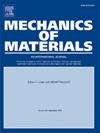斜波加载下晶粒组织不均匀性对中熵合金CoCrNi动态变形机制和裂裂的影响
IF 3.4
3区 材料科学
Q2 MATERIALS SCIENCE, MULTIDISCIPLINARY
引用次数: 0
摘要
通过大规模分子动力学模拟,深入研究了在加载速度为800 ~ 1400 m/s的情况下,晶粒结构不均匀性对CoCrNi中熵合金斜坡波响应和小块破坏行为的影响。在晶粒尺寸分布均匀的均匀纳米晶(UNC)模型中,Hugoniot弹性极限(HEL)随着晶粒尺寸从3 nm增大到9 nm而增大,但随着晶粒尺寸进一步增大到12 nm而减小。这种行为表明主要变形机制由晶间晶界(GB)变形向晶内变形转变。为了进行比较,我们还研究了梯度纳米晶(GNC)模型和非均相纳米晶(HNC)模型。梯度纳米晶(GNC)模型的晶粒尺寸沿加载方向从3 nm到12 nm呈线性变化,而非均相纳米晶(HNC)模型的晶粒尺寸从3 nm到12 nm呈突变变化。在塑性变形过程中,GNC和HNC模型均表现出晶内缺陷增殖(包括位错滑移、层错(SF)和孪晶界(TB)扩展)和晶间GB移动的组合,导致剪切应变均匀化,尤其是在GB处。因此,由晶粒组织不均匀性引起的明显的应变离域促进了GBs与晶粒内部的协同变形,有效地阻碍了空洞的形核和扩展。这导致GNC和HNC模型的小块强度增强。该研究为动态加载条件下多晶MEA的晶粒结构工程设计提供了一种策略。本文章由计算机程序翻译,如有差异,请以英文原文为准。
Effects of grain structure inhomogeneity on dynamic deformation mechanisms and spallation of medium entropy alloy CoCrNi under ramp wave loading
By leveraging large-scale molecular dynamics simulations, the effects of grain structure inhomogeneity on the ramp wave response and spall failure behavior of CoCrNi medium entropy alloy are thoroughly investigated, with loading velocities varying between 800 m/s and 1400 m/s. In the uniform nanocrystalline (UNC) models with homogeneous grain size distribution, the Hugoniot elastic limit (HEL) initially increases as the grain size grows from 3 nm to 9 nm but decreases as the grain size further increases to 12 nm. This behavior suggests a transition in the dominant deformation mechanism from intergranular grain boundary (GB) deformation to intragranular activities. For comparison, gradient nanocrystalline (GNC) models, featuring a linear grain size variation along the loading direction from 3 nm to 12 nm, and the heterogeneous nanocrystalline (HNC) models, exhibiting an abrupt grain size change from 3 nm to 12 nm, are also examined. Both GNC and HNC models exhibit a combination of intragranular defect multiplications (involving dislocation slip, stacking fault (SF), and twin boundary (TB) expansion) and intergranular GB movement during the plastic deformation, resulting in shear strain homogenization, especially at the GBs. Consequently, the pronounced strain delocalization caused by grain structure inhomogeneity promotes cooperative deformation between GBs and grain interiors, effectively hindering void nucleation and expansion. This leads to enhanced spall strength in both the GNC and HNC models. This study provides a strategy of grain structure engineering for designing polycrystalline MEA under dynamic loading conditions.
求助全文
通过发布文献求助,成功后即可免费获取论文全文。
去求助
来源期刊

Mechanics of Materials
工程技术-材料科学:综合
CiteScore
7.60
自引率
5.10%
发文量
243
审稿时长
46 days
期刊介绍:
Mechanics of Materials is a forum for original scientific research on the flow, fracture, and general constitutive behavior of geophysical, geotechnical and technological materials, with balanced coverage of advanced technological and natural materials, with balanced coverage of theoretical, experimental, and field investigations. Of special concern are macroscopic predictions based on microscopic models, identification of microscopic structures from limited overall macroscopic data, experimental and field results that lead to fundamental understanding of the behavior of materials, and coordinated experimental and analytical investigations that culminate in theories with predictive quality.
 求助内容:
求助内容: 应助结果提醒方式:
应助结果提醒方式:


